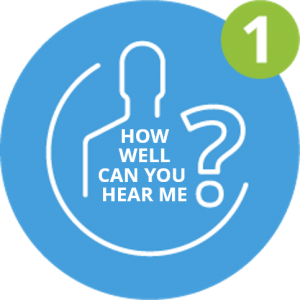Remember the icon on the last section “How well can you hear me now?” It has nothing to do with the famous ad, it just emphases how important the voice quality is in overall quality of service concept. Think why you need your phone. What was the primary reason when you bought it? 90% of you would say that you need to stay in touch with your families and friends. And despite Internet booming, voice calls continue to be the most demanded services, no matter whether they are carried out traditionally or through numerous voice over IP applications.
If so, it is reasonable to say that voice quality is crucial both for subscribers and operators. In spite of all technical progress the measurement of voice quality seems to be a problem. Why so?
It is all about perception again. Let’s get back to the dawn of telecom and see how our colleagues used to measure voice quality at that time. They had specially trained experts who were responsible for listening to reference phrases over the lines and making conclusions as to how well they heard the speech based upon 5-grade scale. In other words, they expressed their opinion after a voice quality test. Then since it was always a group of people, the averaging procedure was applied, and the result was mean opinion score, so to say, how people perceive quality in average.
Of course, it was expensive and rather technical, and the experts were not regular subscribers but it was the most adequate evaluation of what people think of quality.
Later, computers replaced the experts but till recently it was a challenge to replicate what experts had been doing so well. Even nowadays the classical approach is still nothing but a standard to all modern algorithms like PESQ and POLQA.
One of the outstanding features of Mobile Quality Analyzer (MQA) is a capability of measuring voice quality according to PESQ and POLQA patented techniques with a close replication of customer behavior. The later means measurement between two mobile devices, emulating a real conversation with ‘speeches’ and ‘pauses’. Moreover, realizing that the measurement results depend on language of reference audio records, we took care of it as well to provide you with the most accurate and reliable output. Finally using our L2/L3 data collected by MQA you have an opportunity to find a reason behind the current voice quality level.
And there is another interesting feature of MQA. It is the ability to measure Internet speed over mobile networks. You may wonder what is so special about our product in this particular area, since there is a huge number of applications that have the same function. The answer is that we know exactly what we do. For example, we know very well what the main sources of measurement errors are and how to minimize them. Let’s say you want to know the maximum speed your network can provide. Then ask yourself these questions:
– how would I select data source, a server that provides a stable data stream?
– how to launch benchmarking measurement?
– how many download threads do I need to open?
– what would be a buffer size?
– what is the duration of a single measurement session?
– how to select and verify measurement locations using MQA as a drive test equipment?
Of course, there are no great revelations, and you can answer all those questions on your own. It is just a matter of time. Or you may appeal to our 10-year experience and products designed with embedded answers.
We intentionally stop at this point having slightly disclosed coverage measurement and network troubleshooting issues, since it is a rewarding topic for a book not for the portal. However, we are ready to discuss them with you upon request, which you may leave here or push ’Send a request‘ button on top.















